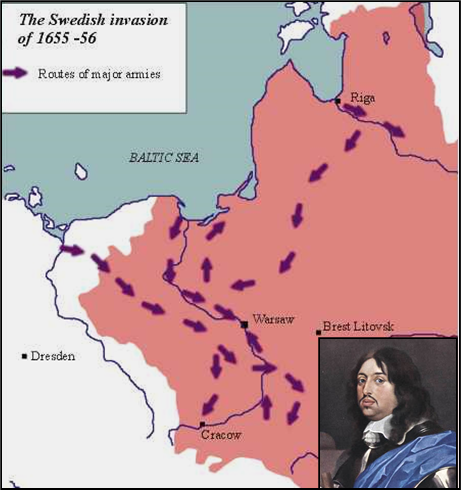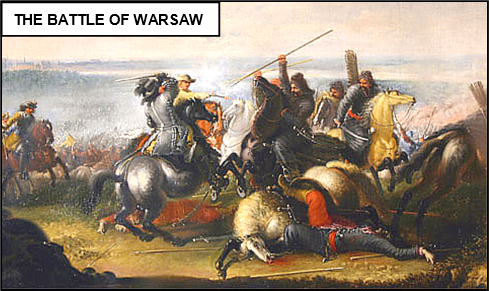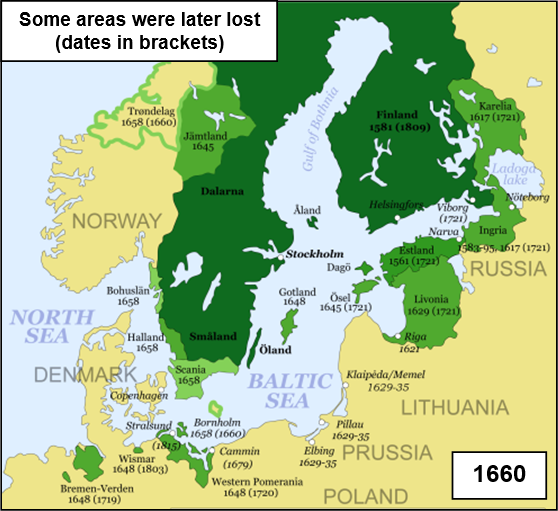


xxxxxBy the Treaty of Westphalia in 1648 (C1) Sweden emerged from the Thirty Years’ War as the dominant Baltic nation. On coming to power in 1654 Charles X planned to expand further. He attacked Poland, winning the Battle of Warsaw in 1656, but, alarmed by this success, his neighbours formed an alliance against him, and he had to retreat. Undeterred, he attacked Denmark and, gaining some land, launched a second attack in 1659, aiming to establish a unified Scandinavian state. This time, however, the Danes stood firm, held on to Copenhagen, and drove him back. He died the following year. But Sweden’s days of conquest were not over. As we shall see, the Great Northern War of 1700 (W3) was to provide the stage for the warrior king Charles XII, one of Europe’s greatest military monarchs.
CHARLES X OF SWEDEN
1654 -
Acknowledgements
Map (Poland):
from britishbattles.homstead.com. Charles X
(inset): by the French painter Sébastien Bourdon (1616-
 xxxxxAs we have seen, Sweden emerged from the Thirty Years
War weary but triumphant. Despite the tragic loss of their
charismatic leader, Gustavus Adolphus at the Battle of Lutzen in
1632, the entry of Roman Catholic France into the conflict three
years later -
xxxxxAs we have seen, Sweden emerged from the Thirty Years
War weary but triumphant. Despite the tragic loss of their
charismatic leader, Gustavus Adolphus at the Battle of Lutzen in
1632, the entry of Roman Catholic France into the conflict three
years later -
xxxxxSuch
was the position when the warrior King Charles X (illustrated) succeeded to the throne in 1654. The constant
military campaigns had brought his country close to bankruptcy, but
he was determined to expand at the expense of nations which had been
more seriously weakened by the rigours of the Thirty Years' War. In
1655 he invaded Poland on a trumped- es.
Denmark, Russia and the Holy Roman Empire declared war on Sweden,
and Frederick William, having reached an agreement with the Poles, promptly joined them.
es.
Denmark, Russia and the Holy Roman Empire declared war on Sweden,
and Frederick William, having reached an agreement with the Poles, promptly joined them.
xxxxxIn
the face of such an alliance, Charles was obliged to withdraw from
Poland, but he now cast his eyes on Denmark. In a daring attack
which has earned a place in military history, he led his troops over
a stretch of water called the Belts -
 xxxxxSpurred on by this victory, Charles now sought the
complete conquest of his neighbour in a bid to establish a unified
Scandinavian state. In a surprise attack, he seized Funen and
attacked Zealand, but this time the Danes stood firm. They put up an
heroic defence of Copenhagen in the winter of 1659, led by Frederick
III, and the Swedish king was forced to retire. He died soon
afterwards, and then a series of treaties in 1660 and 1661 -
xxxxxSpurred on by this victory, Charles now sought the
complete conquest of his neighbour in a bid to establish a unified
Scandinavian state. In a surprise attack, he seized Funen and
attacked Zealand, but this time the Danes stood firm. They put up an
heroic defence of Copenhagen in the winter of 1659, led by Frederick
III, and the Swedish king was forced to retire. He died soon
afterwards, and then a series of treaties in 1660 and 1661 -
xxxxxThe Swedes retained much of the land seized from Denmark, but they returned Trondheim and the island of Bornholm, and their hopes of a united northern state were not realised. However, as we shall see, the days of Sweden's greatness were far from over. The Great Northern War, which broke out in 1700 (W3) was to provide the stage for the entry of Charles XII, one of the greatest military kings in European history.
CW-


